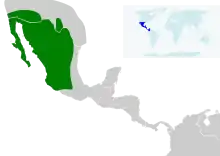Pocketed free-tailed bat
The pocketed free-tailed bat (Nyctinomops femorosaccus) is a species of bat in the family Molossidae found in Mexico and in Arizona, California, New Mexico, and Texas in the United States. They resemble the Brazilian free-tailed bat (Tadarida brasiliensis) but differ morphologically. They are recognized as "least concern" by the IUCN and as "apparently secure" by Natureserve.[2]
| Pocketed free-tailed bat | |
|---|---|
.jpg.webp) | |
| Scientific classification | |
| Domain: | Eukaryota |
| Kingdom: | Animalia |
| Phylum: | Chordata |
| Class: | Mammalia |
| Order: | Chiroptera |
| Family: | Molossidae |
| Genus: | Nyctinomops |
| Species: | N. femorosaccus |
| Binomial name | |
| Nyctinomops femorosaccus (Merriam, 1899) | |
 | |
Characteristics
The pocketed free-tailed bat shares similar features with the Brazilian free-tailed bat ("Tadarida brasiliensis") but is larger in size. The name is derived from a skin fold stretching from the medial side of the femur to the middle of the tibia. This fold produces a shallow pocket on the underside of the interfemoral membrane in the vicinity of the knee. Some defining characteristics include: Ears joined at the midline; second phalanx of the 4th digit is less than 5mm; anterior part of hard palate narrowly excised; upper incisors placed close together with longitudinal axes nearly parallel.[3]
The pocketed free-tailed bat also has a large broad head with grooved lips. The face has many stiff hairs with spoonlike tips. The ears are thick and leathery with the presence of a dominant tragus. Body dimensions: body length~112mm; feet~10mm; tail~46mm; ears~23mm; forearms~46mm. Body mass range is 10–14 g (0.35–0.49 oz).[4]
Habitat and ecology
Like many other bats, this species is insectivorous; they eat a variety of insects including Lepidoptera, Hymenoptera, Homoptera, Coleoptera, Hemiptera, Orthoptera, Diptera, and Neuroptera. One research article showed that because of the limited flight maneuverability of the pocketed free-tailed bat compared with the Brazilian free-tailed bat the latter is better able to prey upon beetles. It also showed that the insect species diet for the pocketed free-tailed bats varies with season. In June and July, Lepidoptera accounted for the greatest volume of prey while diets in September and March consisting mostly of Hemiptera[5] Table 1. In the dry season, they seek drinking water from various open access water sources. The roosts are located in caves, crevices, mines, tunnels, and man-made structures [6] with colony sizes less than 100 individuals.[7]
Reproduction
Like some other bats, pocketed free-tailed bats exhibit delayed fertilization. They mate just prior to ovulation in the spring.[8] Their young are born in early July. The gestation period is about 70 to 90 days and when the young are finally born, they weigh 3-4 grams, or about 22% of the adult weight.[9] This new generation is able to fly within 1-1.5 months[10]
References
- Arroyo-Cabrales, J.; Álvarez-Castañeda, S.T. (2015). "Nyctinomops femorosaccus". IUCN Red List of Threatened Species. 2015: e.T14994A22010542. doi:10.2305/IUCN.UK.2015-4.RLTS.T14994A22010542.en. Retrieved 12 November 2021.
- Goodenough, Anne E. (2012). "Differences in two species-at-risk classification schemes for North American mammals" (PDF). Journal for Nature Conservation. 20 (2): 117–124. doi:10.1016/j.jnc.2011.11.001.
- Pocketed Free-tailed Bat. Pocketed Free-tailed Bat. Texas Parks and Wildlife, 01 Jan. 2012. Web. 21 Mar. 2015.
- Lancaster, Eric. "Nyctinomops Femorosaccus Pocketed Free-tailed Bat." Nyctinomops Femorosaccus Pocketed Free-tailed Bat. University of Michigan, 17 Feb. 2000. Web. 21 Mar. 2015.
- Matthews, A. K.; Neiswenter, S. A.; Ammerman, L. K. (2010). "Trophic Ecology of the Free-tailed Bats Nyctinomops femorosaccus and Tadarida brasiliensis (Chiroptera: Molossidae) in Big Bend National Park, Texas". The Southwestern Naturalist. Southwestern Association of Naturalists. 55 (3): 340–346. doi:10.1894/JKF-08.1. S2CID 34585778.
- Melanie Bucci; Yar Petryszyn; Paul R. Krausman (2011). "Bat Occurrence and Use of Archaeological Sites at Three National Monuments in Central Arizona". Journal of the Arizona-Nevada Academy of Science. Vol. 43, no. 1. Arizona-Nevada Academy of Science. pp. 1–5. JSTOR 41510539.
- Arroyo-Cabrales, J.; Álvarez-Castañeda, S.T. (2008), Nyctinomops femorosaccus. The IUCN Red List of Threatened Species
- "Insectivorous Bats." National Park Service, U.S. Department of the Interior, 2 Apr. 2015. Web. 6 Apr. 2015.
- Grzimek, Bernhard (1990). Grzimek's Encyclopedia of Mammals Volume 3. McGraw-Hill Publishing. ISBN 9780079095084.
- Wilson, D.E.; Ruff, S. (1999). Smithsonian Book of North American Mammals. Washington, D.C.: Smithsonian Institution Press.
